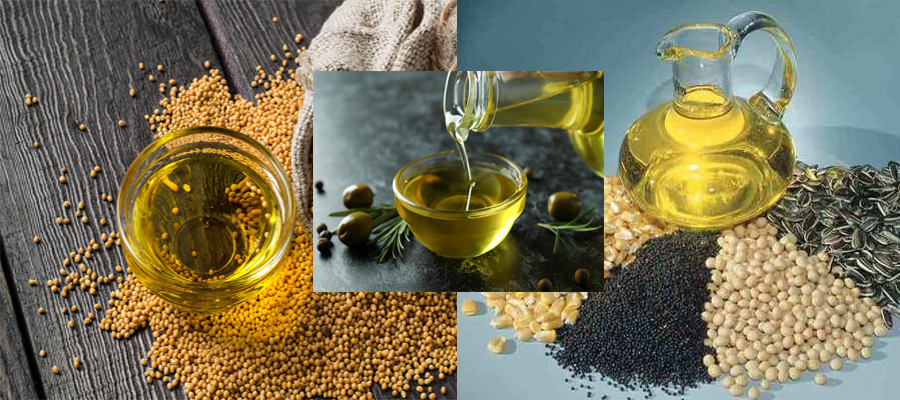
Photo: Collected
We eat to survive. Again, to 'live well' it is necessary to eat a variety of foods. The three main functions of food are (1) production of work energy, (2) body composition and replenishment, and (3) prevention of disease and regulation of internal functions. There are 6 components of food to do all these things such as; (1) Carbohydrates, (2) Meats, (3) Oils or fats, (4) Nutrients, (5) Mineral salts, and (6) Water. The contribution of these foods to keep the body healthy is equal in proportion. Here only the different aspects of different types of oilseeds or fatty food ingredients are discussed.
The function of oil in the human body
* Oil or fat is the main source of dietary energy (twice as much as sugar or meat).
* Oil is a source of essential fatty acids.
* Carrier of fat-soluble vitamins (A, D, E, and K).
* Source of substances useful for producing prostaglandins.
* It is necessary for many other purposes including growth of the body, replenishment of losses, prevention of skin diseases, etc.
How much oil should be consumed?
The amount of meat and food energy required for each person has been determined depending on different age, occupation, environment, etc.; But what amount of oil or fat is needed has not yet been determined. However, according to nutritionists, 15-20% of a person's required dietary energy should come from oil. Then the above-mentioned functions will be completed properly. For example, if an adult needs 21,000 calories per day, 315-420 calories should come from oil. Each gram of oil contains 9 calories. Ideally, 35-47 grams of oil/fat should be consumed daily. According to Indian nutritionists, an average adult should consume at least 20 grams of visible oil per day. It should also be taken into account that there are invisible oils in all the food products we eat (eggs, milk, fish, meat, nuts, etc.).
Children's growing bodies require comparatively more food energy. Since their stomachs are small, their food should be cooked with more flour. Just over 50 grams of groundnuts can meet the daily extra dietary energy needs of expectant mothers or pregnant women.

File Photo
Oils/fats are formed by the addition of glycerol and fatty acids. Lubricants or fats in liquid form are called oils. The percentage of oil is 93-95% fatty acids and 5-7% glycerol. So the properties of an oil depend on the properties of fatty acids. Fatty acids are generally of 2 types. Saturated and unsaturated, the saturated fatty acids found in oils are lauric, myristic palmitic, stearic, etc.; Unsaturated fatty acids are oleic (with 1 double chain). Erucic acid (1 divalent) is present only in mustard oil and ricinoleic acid (1 divalent and 1 hyxyl) is present only in mustard oil and ricinoleic acid (1 divalent and 1 hyxyl) is present in veranda oil. The properties of these fatty acids are discussed in detail in the chapters on mustard and veranda respectively. Unsaturated fatty acids are again of 2 types. Single-chain and multi-chain fatty acids. Fatty acids containing 18 carbon atoms with 1, 2, and 3 bonds are abundant in plant and animal fats. But 4-chain fatty acids with 20-24 and 14-16 carbon atoms are found more in marine plants and marine organisms. Generally, fats rich in unsaturated fatty acids are liquid and fats rich in saturated fatty acids are solid at room temperature such as coconut, palm, cocoa, etc.
A vegetable's oil quality increases if it contains more unsaturated fatty acids. The attached Table 1 shows the number of fatty acids in the oil of approved varieties of oil crops grown in Bangladesh. Among the saturated fatty acids, palmitic and stearic acids are found in higher amounts in vegetable oils. The higher their quantity, the lower the nutritional value of the oil. On the other hand, among the polyunsaturated acids, linoleic and linolenic acids are abundant in vegetable oils. Although these two fatty acids are essential for us, if an oil contains too much of it, the oil spoils quickly and loses its nutritional value. This is discussed in detail in the chapter on sunflower and linseed. Liquid oil is converted into solid fat (Banaspati/Dalda) at room temperature by artificially adding hydrogen atoms to unsaturated fatty acids. It is called hydrogenation
Cholesterol
Cholesterol-conscious people have a kind of fear. Many people think of heart disease, high blood pressure, myocardial infarction, ischemic heart disease, etc. when cholesterol is mentioned. Fear of cholesterol causes many people to avoid many delicious foods. In fact, this is happening because the concept of nutrition is not clear. Cholesterol is an essential element of the body. Cholesterol is high in an animal body. Plants also contain some cholesterol. However, vegetable oil does not contain cholesterol. Cholesterol is present in the cell wall, liver, kidney, brain, etc. 35% of the brain is cholesterol.
Cholesterol we taken with food, and the body produces cholesterol as needed. There are no restrictions on cholesterol intake for normal healthy and active people. However, cholesterol is dangerous in cases of heart disease, polyuria, high blood pressure, and obesity. Excess cholesterol in the body increases the risk of coronary heart disease. According to experts, cholesterol levels in the blood should be between 200 milligrams per 100 milliliters. It is recommended that people at risk of heart disease limit or avoid high-fat foods.
In the UK, oils containing 50 ppm cholesterol are considered cholesterol-free. In the United States, an oil containing 2 mg of dietary cholesterol per serving is considered cholesterol-free. That is, 40 grams of oil containing 50 ppm cholesterol can be consumed per meal.
- SZK based on online Information
Comment Now